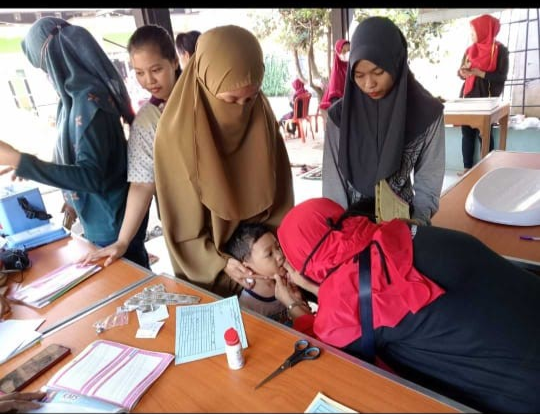Optimalisasi Pemanfaatan Teknologi Informasi Untuk Penginputan Data Posyandu
##plugins.themes.academic_pro.article.main##
Abstract
Technology is getting faster, it turns out that some people cannot use the technology properly. One example is the Dawis Wortel Working Group in the Kembangarum Village, which until now still uses manualization at the time of recording. Any recording in the DAWIS working group is still done manually, that is, only by using the guidelines for recording data in the pokja book. This recording serves to find out how far the health level information is in the Dawis, especially the posyandu recording. This record serves to make it easier to monitor the health level of its citizens, especially toddlers. Because the recording is still manual, it is necessary to hold assistance and training in recording posyandu data using a computer, because recording on a computer will make it easier for officers to find other data and so that the recording can be recorded properly, neatly and clearly. is increasing the use of information technology for pokja, especially the posyandu group.
##plugins.themes.academic_pro.article.details##

This work is licensed under a Creative Commons Attribution-NonCommercial 4.0 International License.
JURPIKAT (Jurnal Pengabdian Kepada Masyarakat) accepts manuscripts that have not been published elsewhere and are not under consideration for publication by other print or electronic media. Authors retain copyright and grant the journal right of first publication with the work simultaneously licensed under a Creative Commons BY-NC License that allows others to share the work with an acknowledgment of the work's authorship and initial publication in this journal.
Authors are able to enter into separate, additional contractual arrangements for the non-exclusive distribution of the journal's published version of the work (eg, post it to an institutional repository, in a journal or publish it in a book), with an acknowledgment of its initial publication in this journal.
License to Publish
The non-commercial use of the article will be governed by the Attribution-NonCommercial 4.0 International (CC BY-NC 4.0). The author hereby grants JURPIKAT (Jurnal Pengabdian Kepada Masyarakat) an exclusive publishing and distribution license in the manuscript include tables, illustrations or other material submitted for publication as part of the manuscript (the “Articleâ€) in print, electronic and all other media (whether now known or later developed), in any form, in all languages, throughout the world, for the full term of copyright, and the right to license others to do the same, effective when the article is accepted for publication. This license includes the right to enforce the rights granted hereunder against third parties.
References
Kementerian Kesehatan RI. 2011. Pedoman Umum Pengelolaan Posyandu. Jakarta.
Pakpahan, Martina, Deborah Siregar, Andi Susilawaty, Tasnim Tasnim, Mustar, Radeny Ramdany, Evanny Indah Manurung, et al. 2021. Promosi Kesehatan Dan Perilaku Kesehatan. Google Books. Yayasan Kita Menulis. https://books.google.com/books?hl=id&lr=&id=MR0fEAAAQBAJ&oi=fnd&pg=PA3&dq=Promosi+kesehatan+dan+perilaku+kesehatan&ots=hfYuh42q03&sig=0hTB8KnEoqpmlCUd9R0ppN8Nr5Y.
Erlin Qur’atul Aini. 2020. “Pengaruh Pengetahuan, Sikap Dan Motivasi Terhadap Kinerja Kader Posyandu Di Puskesmas Kabupaten Banyuwangi.†Repository.unair.ac.id. 2020. https://repository.unair.ac.id/111760/.
Herawati, Desy, Rahmi Hidayati, and Irsyadunnas Noveri. 2020. “Upaya Pemerintah Dalam Program Posyandu Terhadap Peningkatan Kesehatan Anak (Studi Di Posyandu Kecamatan Bajubang).†Repository.uinjambi.ac.id. October 19, 2020. http://repository.uinjambi.ac.id/5707/..
Suryati, Kadek, Ni Wayan Suardiati Putri, and Evi Dwi Krisna. 2020. “Pelatihan Microsoft Excel Dalam Pembelajaran Matematika.†WIDYABHAKTI Jurnal Ilmiah Populer 2, no. 2 (March): 40–48. http://widyabhakti.stikom-bali.ac.id/index.php/widyabhakti/article/view/159. Tuty W, (2015), Mahir Dalam Administrasi Pencatatan Data, Alex Media, Bandung.
Saepudin, Encang, Edwin Rizal, Agus Rusman, Program Studi, and Ilmu Perpustakaan. 2017. “Peran Posyandu Sebagai Pusat Informasi Kesehatan Ibu Dan Anak Posyandu Roles as Mothers and Children Health Information Center.†RECORD and LIBRARY JOURNAL 3, no. 2.
Lubis, Zulhaida. 2015. “Pengetahuan Dan Tindakan Kader Posyandu Dalam Pemantauan Pertumbuhan Anak Balita.†Jurnal Kesehatan Masyarakat 11, no. 1 (September): 65. https://doi.org/10.15294/kemas.v11i1.3473.
Sugiyarti, Retno, Veriani Aprilia, and Febriana Suci Hati. 2014. “Kepatuhan Kunjungan Posyandu Dan Status Gizi Balita Di Posyandu Karangbendo Banguntapan, Bantul, Yogyakarta.†JNKI (Jurnal Ners Dan Kebidanan Indonesia) (Indonesian Journal of Nursing and Midwifery) 2, no. 3 (November): 141–46.
Djamil, Achmad. 2017. “Faktor-Faktor Yang Berhubungan Dengan Perilaku Ibu Balita Menimbang Anaknya Ke Posyandu.†Jurnal Kesehatan 8, no. 1 (April): 127. https://doi.org/10.26630/jk.v8i1.409.

